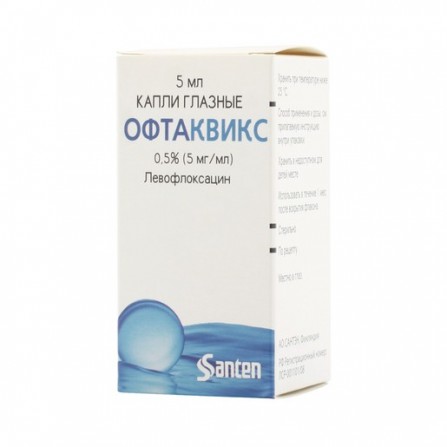Oftaquix eye drops 0.5% 5ml
Condition: New product
1000 Items
Rating:
Be the first to write a review!

More info
Active ingredients
Levofloxacin
Release form
Drops
Composition
1 ml: levofloxacin hemihydrate 5.12 mg, which corresponds to the content of levofloxacin 5 mg Excipients: benzalkonium chloride, sodium chloride, hydrochloric acid, sodium hydroxide, water d / and.
Pharmacological effect
Antimicrobial drug from the group of fluoroquinolones. Levofloxacin is the L-isomer of the racemic drug ofloxacin. The antibacterial activity of ofloxacin is mainly related to the L-isomer. Levofloxacin blocks DNA gyrase and topoisomerase IV, disrupts supercoiling and cross-linking of DNA breaks, suppresses DNA synthesis, causes profound morphological changes in the cytoplasm, cell wall and membranes. Pseudomonas aeruginosa; Gram-positive aerobes: Staphyloccocus aureus, Streptococcus pneumoniae, Streptococcus pyogenes.
Pharmacokinetics
After instillation in the eye, levofloxacin is well preserved in the tear film. In studies on healthy volunteers, it was shown that the average concentrations of levofloxacin in the tear film, measured 4 and 6 hours after topical administration, were 17.0 μg / ml and 6.6 μg / ml, respectively. In five of the six subjects tested, the concentration of levofloxacin was 2 μg / ml and higher 4 hours after instillation. In four out of six subjects, this concentration was maintained 6 hours after instillation. The average concentration of levofloxacin when using Eye drops of Oftaquix in aqueous humor is statistically significant (p = 0.0008) higher than the average concentration of ofloxacin (1139.9 ± 717.1 ng / ml and 621.7 ± 368.7 ng / ml respectively). The average concentration of levofloxacin in the blood plasma 1 h after application — from 0.86 ng / ml to 2.05 ng / ml. Cmax of levofloxacin in plasma, equal to 2.25 ng / ml, was detected on the fourth day after 2 days of the drug every 2 h up to 8 times per day Cmax of levofloxacin, reached on the fifteenth day, was more than 1000 times lower than the concentration observed after ingestion of standard doses of levofloxacin.
Indications
- treatment of superficial bacterial infections of the eye in patients 1 year and older; - prevention of complications after surgical and laser eye surgery.
Contraindications
- pregnancy; - lactation period (breastfeeding); - hypersensitivity to quinolone preparations; - hypersensitivity to the components of the preparation.
Precautionary measures
With caution should use the drug in children.
Use during pregnancy and lactation
Eye drops Oftaquix contraindicated during pregnancy and lactation (breastfeeding).
Dosage and administration
Locally, they are instilled into the affected eye. During the first two days during the waking period, every 2 hours, 1-2 drops to the affected eye, up to 8 times / day. From the 3rd to the 5th day of treatment - 1-2 drops to the affected eye 4 times / day. The duration of the course of treatment is determined by the doctor and is usually 5 days.
Side effects
Often (1-10%): a burning sensation in the eye, reduced visual acuity, the appearance of mucous cords. eye pain, conjunctival hyperemia, conjunctival follicle appearance, dry eye syndrome, eyelid erythema, eye irritation, contact dermatitis, photophobia and allergic reactions. Others: during clinical trials - headache, rhinitis.
Overdose
The total amount of levofloxacin contained in a single vial of eye drops is too small to cause toxic reactions even after accidental ingestion. After topical application of an excessive dose of eye drops, Oftaquix eyes should be washed with clean (tap) water at room temperature.
Interaction with other drugs
Special studies on the interaction of eye drops Oftaquix not conducted. Since the maximum concentration of levofloxacin in plasma after topical application in the eye is at least 1000 times lower than after taking standard oral doses, interaction with other drugs characteristic of systemic use is most likely clinically insignificant.
special instructions
Eye drops of Oftaquix should not be administered subconjunctivally and directly into the anterior chamber of the eye. When using other ophthalmic agents at the same time, the interval between instillations should be at least 15 min. lenses. To avoid contamination of the dropper tip and solution, do not touch the dropper tip to the periorbital tissues.





